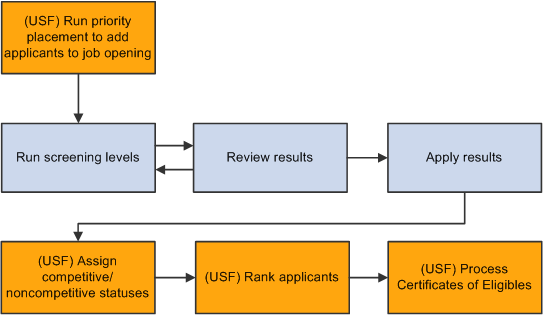Understanding the Screening Process
Screening is the process used by recruiters to evaluate a list of potential candidates and narrow the list to the most qualified applicants.
This topic discusses the process of running screening. It does not discuss how to set up screening. For information about setting up screening, refer to these topics:
Process Overview
The standard screening process involves these steps:
Review and run screening levels for the job.
You can review both the overall list of screening levels and the detailed screening criteria and processing rules for individual screening levels. You can optionally update the screening level details.
Running a screening level applies the screening level settings and assigns applicants a pass/fail result and an overall score.
Review screening results.
Review the pass/fail results, the overall score, and detailed information about how the score was figured. You can also view the applicant data that was used in screening to see if any missing ratings affected the applicant’s score.
You can change screening criteria and rerun the screening levels as many times as you like before continuing to the next step.
Apply screening results.
When you are satisfied with the results, applying them updates applicant dispositions according to the screening level rules. The system applies results to every applicant who has unapplied screening results. You cannot select individual applicants for this step. Applicants whose results have been applied are not included in any further screening processing.
Image: Basic process flow for applicant screening
This diagram illustrates the basic flow for screening applicants.

At the conclusion of this process, you are ready to continue to the routing process, where you can seek feedback from others regarding the next recruiting steps for individual applicants.
(USF) Extended Process for Federal Users
The screening process for U.S. federal government jobs involves some additional steps:
At the beginning of the process, you run the RS - Priority Placement (HRS_PRI_PLCM) Application Engine process to automatically add priority placement applicants to the job opening.
The RS - Priority Placement process adds applicants with a priority placement code and salary grade and level that match the job opening. (The priority placement code by itself is not sufficient.)
After you finish running screening levels and applying results, you rank applicants and generate the Certificate of Eligibles.
To accomplish this, you need to:
Assign competitive/non-competitive statuses to applicants.
Applicants without a competitive/non-competitive status are excluded from the ranking process.
Rank applicants according to their cumulative screening scores, augmented by preference items.
Generate a Certificate of Eligibles listing the ranked applicants.
Image: Additional steps for U.S. federal screening processes
This diagram illustrates additional steps for US federal screening.
